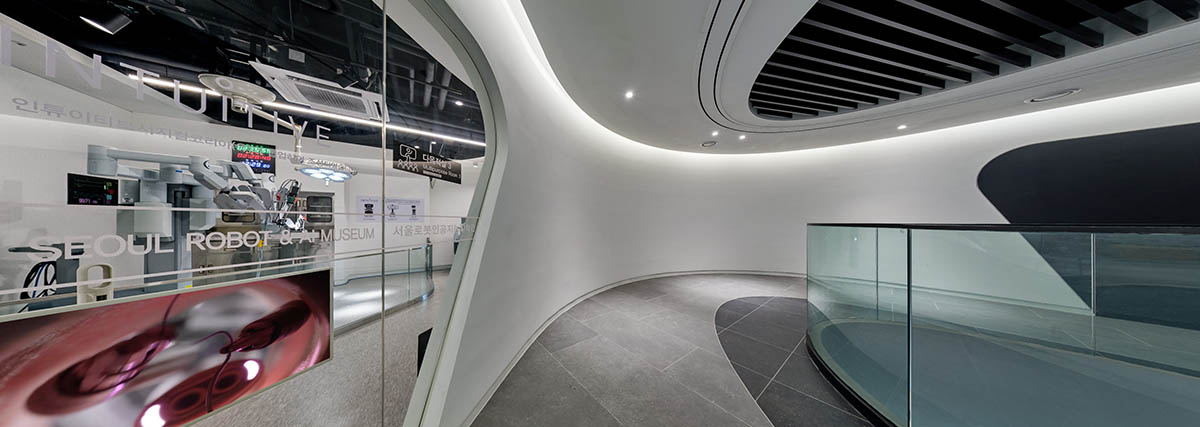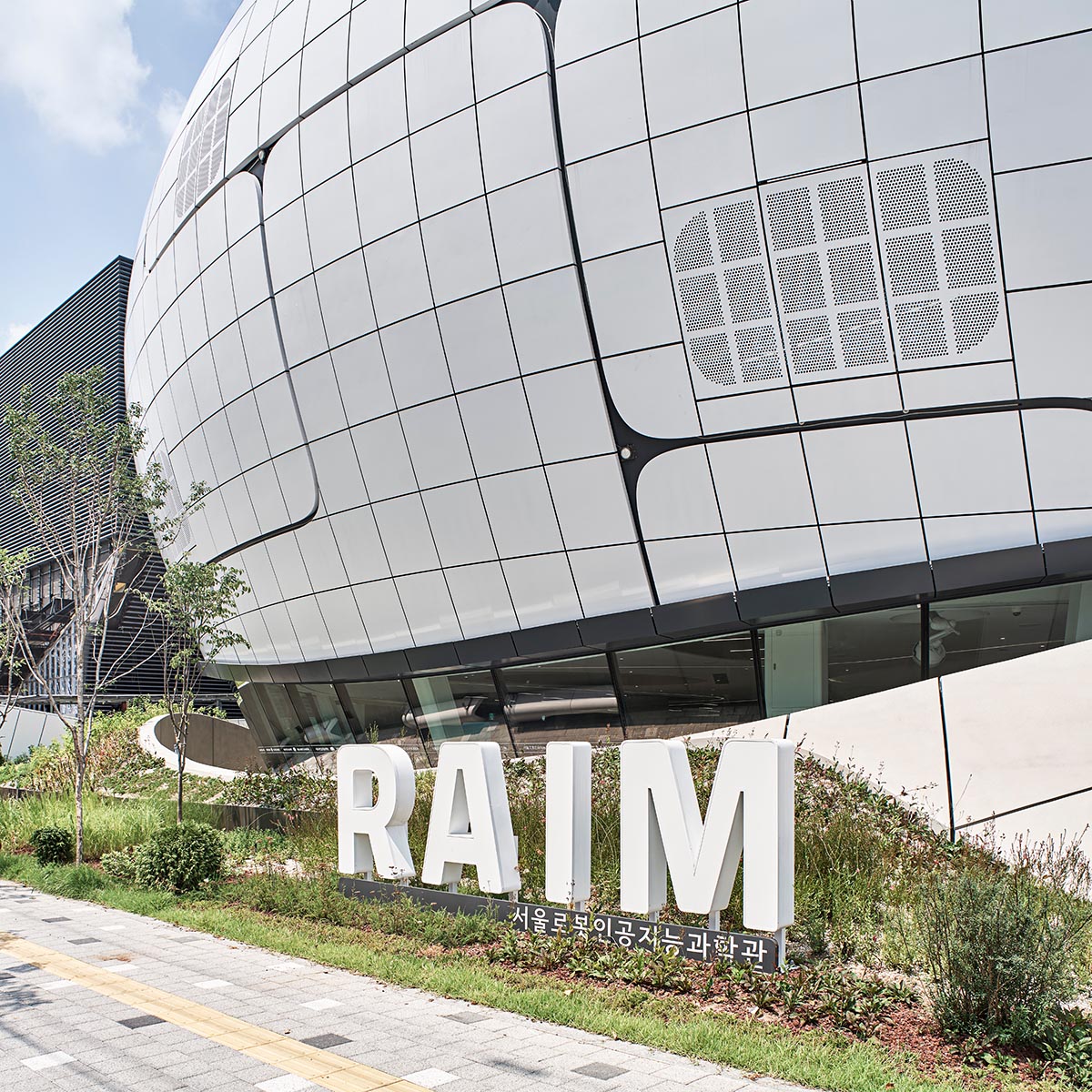Submitted by WA Contents
Melike Altınışık Architects completes the world's first pioneer robot & AI museum in Seoul
Korea, South Architecture News - Oct 16, 2024 - 12:50 6439 views

Melike Altınışık Architects (MAA) has completed the world's first pioneer robot & AI museum in Seoul, South Korea.
Named Seoul Robot & AI Museum (RAIM), the 7,400-square-meter museum has officially opened to the public in Seoul, South Korea.
Located in the northeastern region of Seoul, RAIM, the world's first pioneer Robot & AI Museum, is a cultural landmark that will serve as a hub the for the fourth industrial revolution.

The museum was realized by MAA in collaboration with Korean firm Withworks, and becomes an excellent example of cutting-edge architectural and construction techniques.
The museum is distinguished by its spherical, non-directional form characterized by fluid, organic shapes that resonate with the advanced technologies.

"This dialogue between contemporary architectural expression and technological innovation forms the foundation of RAIM's design philosophy," said MAA, led by Melike Altınışık.
"The architectural form of RAIM is not merely an envelope but an integral part of the museum’s narrative, reflecting the fluidity and dynamism of the AI and robotics fields."
"The building’s design fosters an ongoing interaction between its innovative form and the groundbreaking technologies it showcases," the studio added.

The four-storey museum includes a library, shop and cafe, education spaces, offices, exhibitions, special exhibition room and event space. The museum also has two basement floors that are used for car parks and technical service facilities.
The goal of RAIM is to promote innovation, science, and technology development and dissemination. By motivating and involving the community, it seeks to make a major contribution to the growth of Seoul's AI industry ecosystem, the studio explains.

The museum offers a venue for exhibitions, interactive experiences, and educational programs centered around robotics and artificial intelligence.
Its strategic location aims to foster public-researcher connections with researchers from surrounding universities, research institutes, and corporations.
RAIM is positioned as a key node in the regional science and culture network because of its integration of academia, industry, and public engagement.

RAIM will be further integrated into the local cultural landscape through planned exhibitions and partnerships with neighboring cultural and entrepreneurial establishments like "Chang-dong Aurene," "Seoul Museum of Photography," and "Startup and Cultural Industrial Complex."
It is anticipated that these projects will boost the regional economy and advance Chang-dong Sanggye's cultural renaissance.

RAIM is "a living exhibition"
MAA design principal Melike Altınışık describes RAIM as "a living exhibition, where the architecture embodies the very smart technologies it exhibits."
"The museum is not merely a space for displaying robots; it integrates smart technologies from design and construction through to operation, making it a seamless part of the technological narrative it presents," said Altınışık.

The journey is introduced by friendly robots at the entrance, where visitors start their experience at RAIM. The ground floor creates a seamless connection between the interior spaces and the external public realm with its reception, ticket halls, café, and shop.
The vertical exhibition tunnel, which connects the museum's upper floors to the permanent and temporary exhibitions, blurs the line between the physical world and the world of robotics and artificial intelligence. The second floor houses the administrative and educational spaces.

The goal of this spatial design is to guide visitors through a story of scientific and technological advancement while inspiring a sense of exploration and discovery.

Building Information Modeling (BIM) was used to ensure precision in both design and construction during the museum's construction, utilizing smart building techniques.
The process made use of Off-Site Construction (OSC) techniques, which made it possible to realize the museum's intricate, non-linear forms in an effective and high-quality realization.

Using cutting-edge 4th industrial revolution technologies, RAIM's symbolic exhibition began with the implementation of the non-directional spherical exterior, the fluid-like gate, the escalator tunnel that seems to lead visitors into an unknown world, and the numerous non-linear RAIM shapes applied here and there onto the ground.
Image © MAA
The smooth, spherical exterior design was produced by combining reverse engineering and digital fabrication. Robot welding and laser CNC machining were used in the construction process to ensure high precision and few mistakes in the complex façade's execution.
A prominent architectural feature of the museum, the central vertical exhibition tunnel was built with cutting-edge technologies usually only found in the aerospace and marine industries, underscoring the creative approach that pervaded the entire project.

Image © MAA
"RAIM is more than a museum"
"RAIM is more than a museum; it is a symbol of the future of architecture, science, and technology in Korea. It embodies the potential of robotics and AI to redefine our built environment, serving as a landmark for Korea's 4th Industrial Revolution," said MAA.
"It stands as a testament to the fusion of advanced architectural practices and cutting-edge technology, marking a new era in museum design and cultural engagement."

Image © MAA
"Through its smart design and construction, RAIM not only showcases the future but actively participates in its creation, making it a pivotal institution in the ongoing evolution of architecture, science, and technology," MAA added.
"As an architectural and cultural icon, RAIM will play a critical role in shaping the discourse around the integration of smart technologies into our daily lives, offering a space for reflection on the ethical and humanistic implications of these advancements," MAA concluded.

Image © MAA

Image © MAA





Image © MAA

RAIM Exploded + Non-Directional diagram

RAIM Interior Atmosphere diagram

RAIM abstract model

RAIM detailed model

RAIM detailed model
MAA won an international competition to build the world’s first Seoul Robot & AI Museum in 2019. In addition, the studio designed the futuristic supertall TV and Radio Tower in Istanbul, Turkey.
Project facts
Project: Seoul Robot & AI Museum
Client: Seoul Metropolitan Government
Location: Seoul, South Korea
Date: 2019 - 2024
Size: 7,400m2
Design Architect: MAA - Melike Altınışık Architects
Architect of Record: MAA-Melike Altınışık Architects + Withworks
Engineers & Consultants
Structural Engineer: Dongyang, MetalYapı ENG
MEP Engineer: Hanil MEC
Civil Engineer: NOW GIO
Landscape Architect: Green Culture, AU Landscape
Landscape Lighting Consultant: Meitech
Signage & Wayfinding Design: MAA
Exhibition Planner: XOBIS
Certification: SB Environment
General Contractor: LC Construction
Façade Contractor: Dongyang GTS, Façade Tech
All images © Namsun Lee unless otherwise stated.
All drawings © MAA.
> via MAA
AI AI museum MAA Melike Altınışık Architects museum robot museum Seoul
